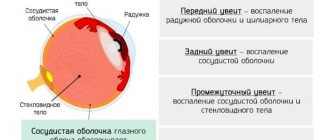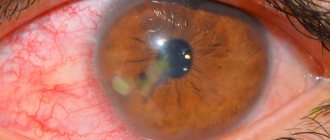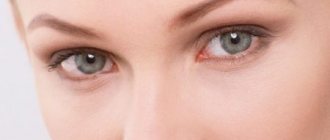When a person has dazzle in his eyes, most often he believes that it is due to overwork. In fact, in most cases this is true. However, this type of visual impairment can also occur with certain diseases of the eyes or nervous system. Therefore, if the feeling of ripples occurs regularly and does not go away for a long time, you should consult an ophthalmologist.
Why does it dazzle your eyes?
The exact causes of the condition can only be identified by a specialist after a thorough examination. Perhaps the ripples in the eyes are a sign of several pathologies of the body, or perhaps caused by ordinary fatigue. Doctors identify the following main causes of this disease:
- Cervical osteochondrosis is a disease in which the nerve endings of the upper spine are pinched. Any careless movement can cause pain in the neck and head, ripples and “dancing” dots before the eyes, and nausea.
- Sedentary lifestyle. When a person stays in one position for a long time and suddenly stands up, the likelihood of ripples in the eyes is very high. This phenomenon is often accompanied by dizziness and may indicate problems with the blood vessels.
- Pathologies of the heart and blood vessels. Almost all diseases related to the heart, blood circulation and blood pressure can cause ripples in the eyes.
- Diseases of the retina and vitreous body.
Sometimes it dazzles the eyes of women during pregnancy. This is due to increased blood circulation, resulting in compression of the blood vessels. After the birth of the child, blood circulation in the mother’s body is normalized and temporary blurred vision disappears.
If ripples in the eyes appear very often, then you should consult a doctor. First, you can make an appointment with an ophthalmologist to rule out ophthalmological diseases.
Prevention
To prevent the appearance of ripples before your eyes, you must follow the following recommendations:
- do not overwork;
- do eye exercises every day;
- adhere to a healthy diet;
- to refuse from bad habits;
- Regularly see an ophthalmologist to diagnose eye diseases.
Rippling before the eyes is not always a harmless symptom. A constantly occurring condition indicates a malfunction in the body. To identify and treat them, you need to undergo an examination by an ophthalmologist.
Leave your tips in the comments and share the article on social networks. Take care of your health, all the best.
Ripples in the eyes and headache
Ripple accompanied by headache can be caused by:
- alcohol abuse;
- smoking;
- lack of oxygen in the air;
- stress;
- overwork;
- weather change;
- mechanical injury to the eye or head.
People who are weather dependent often face this problem. Changes in atmospheric pressure give rise to many unpleasant symptoms, including migraines.
Causes of flashes before the eyes
Sometimes such complaints are a benign condition associated with excessive visual stress or age-related changes in the eye. However, more often than not, the cause of outbreaks is a serious problem that requires immediate medical attention. The causes of the condition may be:
- Posterior vitreous detachment. The gel-like substance that fills the central part of the eye and is attached to the retina is called the vitreous body. With age, it gradually shrinks, peeling off from its original place. This process retracts the retina, causing flashes to appear in the eyes. Similar symptoms are noticeable when moving the eye. There is no specific treatment for this condition. However, patients with this diagnosis must undergo regular ophthalmological examinations. Sometimes, such symptoms hide a more dangerous pathology - retinal detachment, which can cause irreversible vision loss - blindness.
- Retinal detachment or tears. Very often, flashes of light are a symptom of a violation of the integrity of the retina and the beginning of its detachment. It is necessary to pay special attention to the situation if such a condition appears after physical activity (heavy lifting) or serious nervous stress. In this case, flashes of light are often accompanied by the appearance of a veil in front of the affected eye and a sudden decrease in visual acuity. In case of retinal detachment, urgent medical attention is required - surgery.
- Migraine. Similar visual symptoms may precede headache attacks. In this case, flashes of light take the form of bright white zigzags, sparks or geometric shapes. As a rule, they are localized in the periphery of the visual field in one eye or two at the same time. Light flashes of light in the eyes occur without headache attacks. This phenomenon is called ocular migraine. They do not fall within the competence of an ophthalmologist; they are dealt with by neurologists.
- Vascular diseases. Such pathologies include: hypertension, atherosclerosis, diabetes mellitus, etc. Patients note the periodic occurrence of flashes before closed eyes or in the dark. The condition is caused by short-term vascular spasms with impaired blood circulation in the retinal tissue. As a rule, in this case, manifestations of angiopathy or retinopathy are visible in the fundus.
- Cervical osteochondrosis. When the vertebral arteries (pass in the bone canals of the cervical vertebrae) are compressed, the blood supply to the brain (including the cerebellum) is disrupted, so not only visual disturbances appear, but also dizziness. Often, vertebral artery syndrome (VAS) occurs in people who work at a computer for a long time and lead a sedentary lifestyle.
- Intracranial tumors of the occipital lobe of the brain. In this case, visible phenomena differ in shape and color and have a constant nature of occurrence.
- Inflammatory processes in the retina and choroid of the eye. The diseases that cause them are called retinitis and choroiditis and always occur against the background of accompanying signs of inflammation: blurred vision, decreased visual acuity.
Diagnosis and treatment
To determine what causes ripples in the eyes and headaches, a detailed analysis of the attack is necessary, characterizing the symptoms according to the following parameters:
- frequency,
- duration,
- provocateur
Observations of your condition during attacks should be recorded in a diary. Records of pressure readings when ripples appear in the eyes, headache increases, decreases, and sensations after an attack help to see the full picture of the ailment. The study of indicators serves to correctly determine the disease and select a treatment method. Keeping entries in a diary for 7-10 days is considered sufficient for choosing the direction of medical research.
Medical diagnostics includes the following studies:
- 1. Analysis of symptom manifestations.
- 2. Physical examination.
- 3. Study of medical and family history.
- 4. Computer or magnetic resonance imaging (CT, MRI).
Rules for prescribing therapy
Treatment is based on eliminating the provoking factor and usually involves:
- 1. Prescription of antibacterial and antiviral agents for the infectious nature of the disease.
- 2. Normalization of blood pressure in vascular pathologies.
- 3. Lowering glucose levels, reviewing the main treatment for diabetes.
- 4. Early delivery for eclampsia.
- 5. Iron supplements to increase hemoglobin levels in anemia.
- 6. Physical therapy, massage for osteochondrosis.
- 7. Decongestant, neuroprotective and symptomatic therapy for traumatic brain injuries.
For migraine
Migraines have no cure. The main goals of therapy for migraine are to cope with an attack of pain in a short period and reduce the number of attacks.
The treatment plan includes lifestyle control measures:
- stress management,
- preventing migraine triggers,
- taking medications.
When treating migraines, painkillers are prescribed:
| Group of drugs | Name |
| Analgesics and anti-inflammatory nonsteroidal |
|
| Triptane |
|
| Ergot preparations |
|
Alternative measures to prevent migraine attacks include:
- 1. Meditation, acupressure or acupuncture.
- 2. Exclusion from the diet of foods that contain headache-provoking ingredients:
- alcohol,
- caffeine,
- flavor enhancers: monosodium glutamate,
- nitrates (a preservative in meat),
- aspartame (sugar substitute),
- tyramine, which occurs naturally in some foods.
With VSD
Therapy for VSD is individual for each patient. Its direction is determined by the etiology and characteristics of autonomic disorders. Non-drug treatment involves compliance with:
- daily routine,
- optimization of physical activity,
- restrictions on emotional stress (TV, computer),
- healthy and regular diet.
The treatment regimen should include physiotherapeutic procedures, such as:
- acupuncture,
- laser puncture,
- vacuum therapy,
- electrical stimulation,
- massotherapy.
If ineffective, it is necessary to prescribe individual drug treatment aimed at:
- sanitation of foci of chronic infections,
- somatic, endocrine disorders.
A correctly selected course of treatment, followed for a long time, helps to optimize the patient’s condition and serves to prevent the occurrence of vegetative crises with impaired visual function and headaches.
Diagnosis of the disease
Before starting treatment for such a symptom, it is very important to correctly identify the reason why ripples occur in the eyes. This can only be done by a specialist who will conduct a complete diagnosis. The patient is required to keep a special diary in which it is necessary to record the time of manifestation of characteristic symptoms and his condition at the same time.
The frequency, duration and strength with which the ripples appear in the eyes are also indicated, and pressure readings during this period and after their complete disappearance are recorded. Other symptoms that appear together are also noted here. All these indicators are recorded in the diary throughout the week. This will help to find out and determine the full picture of the course of the disease, without delaying the start of treatment for the disease.
If there is dazzle in the eyes, it is also important to start treatment on time. Therapy consists of eliminating the cause that caused this phenomenon.
In other words, if during the diagnosis it is determined that the ripples in the eyes appeared as a result of infection, then you need to take a course of antibiotics. If such unpleasant symptoms appear due to changes in the structure of the eye, then it is necessary to consult an ophthalmologist, take prescribed eye drops, tablets and injections. In case of retinal dissection, surgical intervention is prescribed.
If ripples in the eyes are associated with headaches, then therapy also depends on the reasons that cause it.
Migraine is treated in the following ways:
- Pyrethrum is a plant that has been used by healers since ancient times. Relieves spasmodic pain in the head. Used as a tincture no more than 30 drops per day.
- For headaches caused by osteochondrosis, a course of massage of the collar area helps well. The ripples in the eyes will go away if you take breaks and light physical exercises on the neck area during sedentary work.
- If headaches and ripples in the eyes are caused by overexertion or prolonged stress, then taking sedative medications is recommended. You can also drink a course of rosemary tea, which has a relaxing effect.
Today, medicine has made great strides forward, and many methods are used in the treatment of headaches. Often, such patients are prescribed sanatorium-resort treatment with a set of measures to eliminate headaches.
Pharmacology also presents quite a lot of different tablets that can eliminate symptoms, eliminate unpleasant symptoms and get rid of headaches.
Diagnostics
An ophthalmological examination is always comprehensive, that is, it includes several procedures affecting individual areas of the eyeball. When diagnosing the condition of the eye, special equipment and medical supplies are used, including drops that allow you to dilate the pupil.
The examination takes no more than two hours. During this period, the ophthalmologist determines visual acuity, examines the retinal membrane (the fundus of the eye), and measures the pressure inside the eyes. In exceptional cases, biomicroscopy, that is, examination of the eyeballs under a microscope, may be required.
To diagnose some eye pathologies, an ultrasound procedure is necessary. Thanks to it, the doctor can determine the length and size of the lens. This research method is called echo biometry.
Diagnostics - what does flickering in the eyes mean?
For treatment to be effective and efficient, the first step is to accurately determine the cause of this unpleasant phenomenon. Usually, for this purpose, a full examination of the body is carried out, since the causes of ripples in the eyes can theoretically be associated with the activity of almost any organ (although more often associated with vision and the circulatory system, and the functioning of the brain).
Find out why a conjunctival cyst may occur in a child.
The patient is asked to keep a special diary for a certain period of time, sufficient for correct diagnosis. In this diary, a person should record the time of ripple attacks, their duration, nature, accompanying symptoms, and other useful information. It is also important to measure blood pressure during and after an attack: this information will help the doctor make a correct opinion about the condition of the patient’s blood vessels. As a rule, such a diary is kept for a week - in most cases this is enough.
Find out how to treat eye pressure and what products to use here.
The video shows the diagnosis of the disease:
You should not hesitate and put off going to the doctor until the last minute: ripples in the eyes can be a signal of quite serious problems in the body. And the sooner you start treatment, the greater the likelihood of a speedy, complete recovery without consequences or complications.
Homeopathic treatment of the problem
Flickering and ripples in the eyes are symptoms of numerous ailments, so to eliminate it it is necessary to treat the main disease that caused problems with the visual organs. In different cases, the doctor may prescribe the following measures to combat the disease:
- If a patient is diagnosed with retinal dissection, surgery cannot be avoided, which is prescribed after a complete examination of the patient and study of test results.
- To combat migraines, there are traditional or homeopathic medicines. In case of short attacks of low intensity, Analgin, Paracetamol, Pentalgin, Solpadeine are prescribed. Seizures with moderate intensity can be stopped with the help of drugs such as Amigrenin, Relpax, Naramigran, Trimigren. During severe cases, take Sumatriptan, Metoclopramide or Naramig.
- If the patient suffers from a disease such as osteochondrosis, special gymnastics, massage are prescribed, and a prescription is given for painkillers and chondroprotectors. Medical procedures and baths are indicated; wraps with the application of cosmetic clay have a good effect.
- In cases where the symptoms are caused by a neurological disease, the patient is prescribed sedative medications.
- Folk remedies (rosemary tea, infusion of “maiden pyrethrum”) and sanatorium-resort holidays have a beneficial effect.
- The choice of treatment and medications is made by the doctor after making a diagnosis and collecting an anamnesis.
Such remedies restore the body’s strength without side effects; they have virtually no contraindications. Homeopathic remedies are prescribed only after an accurate determination of the patient’s symptoms and general health.
A qualified homeopathic doctor must prescribe treatment and select the necessary remedies, who will not only suggest the optimal dosage of the drug, but also explain to the patient the correct dosage regimen.
For fatigue and lack of sleep, Cocculus or Nux vomica are prescribed. Sulfur or Natrium muriaticum helps against severe migraines. For pain that occurs after injury, Arnica and Belladonna come to the rescue.
| Remember that you cannot choose homeopathic medicines on your own! |










